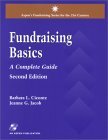Fundraising Basics: A Complete Guide
With Fundraising Basics: A Complete Guide in hand, new fundraisers will be well on their way to a deeper understanding of the key principles and practices of the field. The authors have included a chapter on each of the most common methods for raising money in the nonprofit sector, so that even more experienced practitioners may find this guide useful as they tackle new development challenges. Getting into planned giving for the first time? See Chapter 15, "The Basics of Planned Giving." Never organized a special event? Check out Chapter 12, "Special Events — The Fun in Fundraising."
While there are many books devoted to each particular fundraising strategy, Fundraising Basics is an excellent starting point. In addition to the chapters mentioned above, the authors provide coverage on annual giving programs, direct mail and telemarketing, prospect research, major gift solicitation, corporate and foundation fundraising and capital campaigns. There is also discussion of all the elements that go into making your development program effective: the roles of board members, volunteers and staff; how to set up your development office; using technology in your fundraising; developing and evaluating your fundraising plan; and the core fundraising publications (e.g. the case statement). There's something here for everyone, whether you are building a fundraising effort from scratch or you're an old pro looking for new ideas.
Part of Aspen's Fundraising Series for the 21st Century, Fundraising Basics follows the trend of the series in offering practical, hands-on advice for working with your board, evaluating your fundraising plan, managing your major donors and structuring your capital campaign, among many other topics. Included with the text are many examples — thank you notes, annual appeal letters and response cards, budget forms, etc. In addition, each chapter has an appendix with full-length documents and case studies. For example, after Chapter 11, "Raising Money from Foundations," you will find a sample letter of inquiry and a sample proposal.
The chapter on using technology in fundraising covers everything from developing your technology plan to evaluating fundraising software and using the Internet to raise funds. This is definitely one chapter that could benefit new and experienced fundraisers alike, since many organizations are still learning how to best harness the Internet and other technologies for resource development. "Association Foundation Fundraising" is another interesting chapter addressing a subject that is not often covered in the literature. The authors have a great deal of experience with associations, so this chapter is full of useful tips on how to manage an association/foundation relationship (i.e. board and staff overlap). New fundraisers will appreciate Chapter 18, "Fundraising as a Career," which offers advice on possible career paths and professional development opportunities.
In conclusion, Fundraising Basics belongs at the core of any fundraiser's library. No matter how long you've been in the field, you'll find yourself reaching for this valuable book again and again.
For additional citations to literature on this topic, refer to Literature of the Nonprofit Sector Online, using the subject heading "Fundraising — handbooks, manuals, etc."







